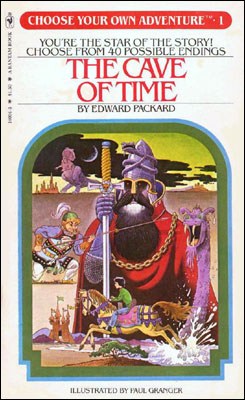 I’ve often said that I like to think about life as a series of forks, a sort-of Choose Your Own Adventure book, in which we’ve already made countless decisions, and whose alternate endings reside only in our dreams. We make these decisions everyday, quite proudly at times when we decide to “reclaim” our lives or “seize the day”. But, do you ever stop to think about the decision points that have already happened? Right now you are living on a timeline entirely of your own doing. The only reason you are sitting where you are right now is because at some point in your life you made a decision that got you there. And, that decision was made only because of a previous decision that had got you to that point. And so on. Think for a moment about something that defines you today, and work your way backward to the first time that you started on the path that would lead to that defining characteristic about yourself today. Then, see if you can work backward again, until you find the node where your current life was initiated. Perhaps an example would help you to understand what I mean. For me, that starting node is the film Amadeus.
I’ve often said that I like to think about life as a series of forks, a sort-of Choose Your Own Adventure book, in which we’ve already made countless decisions, and whose alternate endings reside only in our dreams. We make these decisions everyday, quite proudly at times when we decide to “reclaim” our lives or “seize the day”. But, do you ever stop to think about the decision points that have already happened? Right now you are living on a timeline entirely of your own doing. The only reason you are sitting where you are right now is because at some point in your life you made a decision that got you there. And, that decision was made only because of a previous decision that had got you to that point. And so on. Think for a moment about something that defines you today, and work your way backward to the first time that you started on the path that would lead to that defining characteristic about yourself today. Then, see if you can work backward again, until you find the node where your current life was initiated. Perhaps an example would help you to understand what I mean. For me, that starting node is the film Amadeus.
I am defined by two passions: love of my wife and music. These are two things (unlike natural family) that I decided to put into my life through conscious decision, and that are completely traceable through this practice I describe above. My wife’s entry on my path comes as an interesting by-product of the musical path, and I’m sure I’ll write on that subject at another time.
Why am I a choral musician today? Work backwards, my friend: Because I went to school for music, it appealed to me, and I kept up with it. But, when did I decide to go to music school? At some point in high school, music was the most important class to me, and my teachers were powerful mentors to me? Yes, that’s true, but it produces a dead end. I started on the practical music path in third grade, one would say, with my first violin lessons, but that was not the path that led to all this. The real node that got me interested in pursuing college-level theoretical music (history, theory, analysis) was not my interest in playing music, but rather my interest in score study, which came from my interest in Mozart’s Die Zauberflöte, which came from my interest in Mozart’s music in general, which came from my interest in the film Amadeus, which was introduced to me by a school music teacher in fifth grade. That VHS tape inserted into a rickety AV cart changed my life.
 At two hours and thirty-eight minutes, Amadeus was far too long to be watched in the allotted Music period at school. We saw snippets for a few weeks, and that was supposed to be all we’d need. But, I wanted to see the entire movie, and got my hands on a copy of the tape soon after. I was immediately captivated. The music, the production, the fact that I was watching a movie for grown-ups. All of it combined into an incredibly powerful experience. In the following few years I made it a habit to watch the film at least a few times a year, and I stopped counting at just under twenty viewings. It was my Star Wars, and I had memorized dialogue, music cues, and more.
At two hours and thirty-eight minutes, Amadeus was far too long to be watched in the allotted Music period at school. We saw snippets for a few weeks, and that was supposed to be all we’d need. But, I wanted to see the entire movie, and got my hands on a copy of the tape soon after. I was immediately captivated. The music, the production, the fact that I was watching a movie for grown-ups. All of it combined into an incredibly powerful experience. In the following few years I made it a habit to watch the film at least a few times a year, and I stopped counting at just under twenty viewings. It was my Star Wars, and I had memorized dialogue, music cues, and more.
I purchased the original soundtrack on audio cassette (remember that awkward cardboard sleeve that would hold a two-cassette album together?) and its “music inspired by” sequel. Those three cassettes were played into the ground. A few years later, as compact discs came into their own, I managed the selling of my sister’s Firebird to a dude who came over to the house on a Friday night while she was out on a hot date. My father was disgusted that she had her priorities in that order, and refused to assist with the transaction. But I didn’t care, I had nothing else to do that night! As a thank you, she bought me a three-disc set, in a massive case, the size of a laser-disc or LP record. This was one of the first compact discs I owned, if not the first. I was entranced by the clarity and detail, which had been obscured dreadfully on the cassette medium, especially after years of the magnetic tape being dragged across the playheads in my bedroom, my living room, my Walkman, and our cars. To this day, when I hear any version of the third movement of Mozart’s Piano Concerto No. 22 in Eb, I anticipate a gasping breath that is found on the soundtrack. This was the first time I’d heard woodwind key clicks, conductor and soloist breaths, and so on. How amazing this new world was!
This infatuation with Amadeus led to an infatuation with Mozart. I quickly read all the mainstream books that the public libraries and bookstores had to offer, and in the process learned a lot about how Hollywood plays games with “true” stories in order to create drama and visual appeal. But none of that mattered. To this day, this is my favorite movie, and I know how much of it is incredibly untrue.
 I began to collect those CD’s that I could afford from the Complete Mozart Edition put out by Philips for his bicentennial celebration in 1991. But, with all that music to devour, my primary-source-craving mindset began to develop, and I began to buy the affordable and available Dover scores for each album that I bought. Over time, this score study regimen (as detailed here), led to more scores by more composers and a zest for lifelong music learning. This path defined who I’ve become.
I began to collect those CD’s that I could afford from the Complete Mozart Edition put out by Philips for his bicentennial celebration in 1991. But, with all that music to devour, my primary-source-craving mindset began to develop, and I began to buy the affordable and available Dover scores for each album that I bought. Over time, this score study regimen (as detailed here), led to more scores by more composers and a zest for lifelong music learning. This path defined who I’ve become.
Regarding the movie itself, as mentioned, I know that it is not the most truthful of biographies. As such, I sometimes wonder whether or not it is a movie deserving of its accolades, both from me and all the awards organizations that year, but each time I revisit the picture, I realize why it means so much to me.
This past winter, for Mozart’s birthday, my wife and I decided to watch the director’s cut, which has been available for several years, but which I had put off watching, not out of protest, as some super-fans feel when their favorite movie is re-released some years later with differing intentions, but rather because it is my tendency to save special things for special occasions, and I knew this could be another life-altering experience.
As we watched, I knew that I would instantly recognize the scenes and dialogue that were added to push the feature over three hours. In the end, I do prefer the original theatrical release, but as it is no longer available in any format, it seems I will need to get used to the director’s cut. This newer version adds one subplot and a series of necessary, associated elements. It presents a more dire financial situation for the Mozarts that the original. Wolfgang is presented more hopelessly, and Constanze is given a more pro-active role, as she tries to keep them afoot. This means that at one point, she succumbs to a proposed tryst with Salieri, only to be jilted when he has a change of heart. This one scene haunted me for a nearly a week afterward. It presented Salieri in a darker, more evil light than we’d previously seen, and his actions with Constanze made me feel very uncomfortable. When I gave it more thought, and after a period of time has elapsed, I feel that the fact that she is empowered, albeit only by virtue of her body, it does create a more complex story, though not necessarily more interesting or “better”. But, I do see its merits now.
A few of the theatrically-excised scenes, seem to be poorly acted, poorly shot, and completely superfluous (the scene with the father of the singing student, and all the dogs). This troubled me, making me wonder whether or not the entire movie is this lousy, and I only value it, because of the nostalgia it invokes. Whatever the case, it really doesn’t matter, because this movie is important to me and will remain so.
This is what Amadeus means to me.



